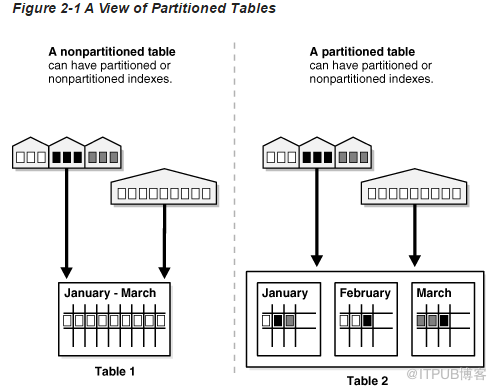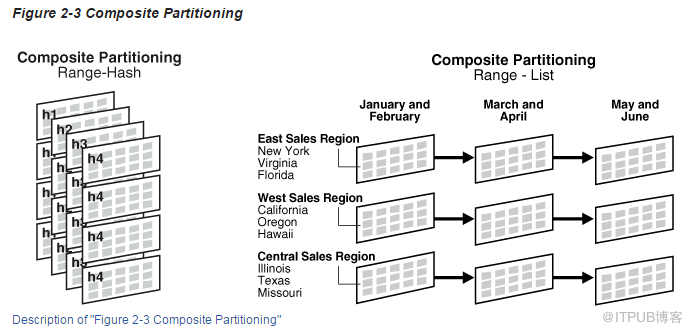您好,登錄后才能下訂單哦!
您好,登錄后才能下訂單哦!

一:When to Partition a Table
Here are some suggestions for when to partition a table:
(1)Tables greater than 2 GB should always be considered as candidates for partitioning.
(2)Tables containing historical data, in which new data is added into the newest partition. A typical example is a historical table where only the current month's data is updatable and the other 11 months are read only.
(3)When the contents of a table must be distributed across different types of storage devices.
二:Partitioning Strategies
A table is defined by specifying one of the following data distribution methodologies, using one or more columns as the partitioning key:
(1)Range Partitioning
(2)Hash Partitioning
(3)List Partitioning
(4)Interval Partitioning
(5)Reference Partitioning
(6)Composite Partitioning

Range partitioning maps data to partitions based on ranges of values of the partitioning key that you establish for each partition.
It is the most common type of partitioning and is often used with dates.
For a table with a date column as the partitioning key, the January-2010 partition would contain rows with partitioning key values from 01-Jan-2010 to 31-Jan-2010.
Each partition has a VALUES
LESS THAN clause, that specifies a non-inclusive upper bound for the partitions. Any values of the partitioning key equal to or higher than this literal are added to the next higher partition. All partitions, except the first, have an implicit lower bound specified by the VALUES LESS THAN clause of the previous partition.
A
MAXVALUE literal can be defined for the highest partition. MAXVALUE represents a virtual infinite value that sorts higher than any other possible value for the partitioning key, including the NULL value.
Creating a Range-Partitioned Table
creates a table of four partitions, one for each quarter of sales. The columns sale_year, sale_month, and sale_day are the partitioning columns, while their values constitute the partitioning key of a specific row. The VALUES LESS THAN clause determines the partition bound: rows with partitioning key values that compare less than the ordered list of values specified by the clause are stored in the partition. Each partition is given a name (sales_q1, sales_q2, ...), and each partition is contained in a separate tablespace (tsa, tsb, ...).
Example 4-1 Creating a range-partitioned table
CREATE TABLE sales
( prod_id NUMBER(6)
, cust_id NUMBER
, time_id DATE
, channel_id CHAR(1)
, promo_id NUMBER(6)
, quantity_sold NUMBER(3)
, amount_sold NUMBER(10,2)
)
PARTITION BY RANGE (time_id)
( PARTITION sales_q1_2006 VALUES LESS THAN (TO_DATE('01-APR-2006','dd-MON-yyyy'))
TABLESPACE tsa
, PARTITION sales_q2_2006 VALUES LESS THAN (TO_DATE('01-JUL-2006','dd-MON-yyyy'))
TABLESPACE tsb
, PARTITION sales_q3_2006 VALUES LESS THAN (TO_DATE('01-OCT-2006','dd-MON-yyyy'))
TABLESPACE tsc
, PARTITION sales_q4_2006 VALUES LESS THAN (TO_DATE('01-JAN-2007','dd-MON-yyyy'))
TABLESPACE tsd
);
Hash partitioning maps data to partitions based on a hashing algorithm that Oracle applies to the partitioning key that you identify.
The hashing algorithm evenly distributes rows among partitions, giving partitions approximately the same size.
Hash partitioning is the ideal method for distributing data evenly across devices. Hash partitioning is also an easy-to-use alternative to range partitioning, especially when the data to be partitioned is not historical or has no obvious partitioning key.
Creating a Hash Partitioned Table
Example 4-5 creates a hash-partitioned table.
The partitioning column is id, four partitions are created and assigned system generated names, and they are placed in four named tablespaces (gear1, gear2, ...).
CREATE TABLE scubagear
(id NUMBER,
name VARCHAR2 (60))
PARTITION BY HASH (id)
PARTITIONS 4
STORE IN (gear1, gear2, gear3, gear4);
The following examples illustrate two methods of creating a hash-partitioned table named dept. In the first example the number of partitions is specified, but system generated names are assigned to them and they are stored in the default tablespace of the table.
CREATE TABLE dept (deptno NUMBER, deptname VARCHAR(32))
PARTITION BY HASH(deptno) PARTITIONS 16;
In the following example, names of individual partitions, and tablespaces in which they are to reside, are specified. The initial extent size for each hash partition (segment) is also explicitly stated at the table level, and all partitions inherit this attribute.
CREATE TABLE dept (deptno NUMBER, deptname VARCHAR(32))
STORAGE (INITIAL 10K)
PARTITION BY HASH(deptno)
(PARTITION p1 TABLESPACE ts1, PARTITION p2 TABLESPACE ts2,
PARTITION p3 TABLESPACE ts1, PARTITION p4 TABLESPACE ts3);
List partitioning enables you to explicitly control how rows map to partitions by specifying a list of discrete values for the partitioning key in the description for each partition.
The advantage of list partitioning is that you can group and organize unordered and unrelated sets of data in a natural way.
For a table with a region column as the partitioning key, the East Sales Region partition might contain values New York, Virginia, and Florida.
The DEFAULT partition enables you to avoid specifying all possible values for a list-partitioned table by using a default partition, so that all rows that do not map to any other partition do not generate an error.
Creating List-Partitioned Tables
Example 4-7 creates a list-partitioned table.
It creates table q1_sales_by_region which is partitioned by regions consisting of groups of U.S. states.
CREATE TABLE q1_sales_by_region
(deptno number,
deptname varchar2(20),
quarterly_sales number(10, 2),
state varchar2(2))
PARTITION BY LIST (state)
(PARTITION q1_northwest VALUES ('OR', 'WA'),
PARTITION q1_southwest VALUES ('AZ', 'UT', 'NM'),
PARTITION q1_northeast VALUES ('NY', 'VM', 'NJ'),
PARTITION q1_southeast VALUES ('FL', 'GA'),
PARTITION q1_northcentral VALUES ('SD', 'WI'),
PARTITION q1_southcentral VALUES ('OK', 'TX'));
Interval partitioning is an extension of range partitioning which instructs the database to
automatically create partitions of a specified interval when data inserted into the table exceeds all of the existing range partitions.
You must specify at least one range partition.
The range partitioning key value determines the high value of the range partitions, which is called the transition point, and the database creates interval partitions for data with values that are beyond that transition point.
The lower boundary of every interval partition is the non-inclusive upper boundary of the previous range or interval partition.
Creating Interval-Partitioned Tables
Example 4-4
specifies four partitions with varying interval widths. It also specifies that above the transition point of January 1, 2010, partitions are created with an interval width of one month.
CREATE TABLE interval_sales
( prod_id NUMBER(6)
, cust_id NUMBER
, time_id DATE
, channel_id CHAR(1)
, promo_id NUMBER(6)
, quantity_sold NUMBER(3)
, amount_sold NUMBER(10,2)
)
PARTITION BY RANGE (time_id)
INTERVAL(NUMTOYMINTERVAL(1, 'MONTH'))
( PARTITION p0 VALUES LESS THAN (TO_DATE('1-1-2008', 'DD-MM-YYYY')),
PARTITION p1 VALUES LESS THAN (TO_DATE('1-1-2009', 'DD-MM-YYYY')),
PARTITION p2 VALUES LESS THAN (TO_DATE('1-7-2009', 'DD-MM-YYYY')),
PARTITION p3 VALUES LESS THAN (TO_DATE('1-1-2010', 'DD-MM-YYYY')) );
Reference partitioning enables the partitioning of two tables that are related to one another by
referential constraints. The partitioning key is resolved through an existing parent-child relationship, enforced by enabled and active primary key and foreign key constraints.
The benefit of this extension is that tables with a parent-child relationship can be logically equipartitioned by inheriting the partitioning key from the parent table without duplicating the key columns. The logical dependency also automatically cascades partition maintenance operations, thus making application development easier and less error-prone.
Creating Reference-Partitioned Tables
Example 4-9
creates a parent table orders which is range-partitioned on order_date. The reference-partitioned child table order_items is created with four partitions, Q1_2005, Q2_2005, Q3_2005, and Q4_2005, where each partition contains the order_items rows corresponding to orders in the respective parent partition.
CREATE TABLE orders
( order_id NUMBER(12),
order_date TIMESTAMP WITH LOCAL TIME ZONE,
order_mode VARCHAR2(8),
customer_id NUMBER(6),
order_status NUMBER(2),
order_total NUMBER(8,2),
sales_rep_id NUMBER(6),
promotion_id NUMBER(6),
CONSTRAINT orders_pk PRIMARY KEY(order_id)
)
PARTITION BY RANGE(order_date)
( PARTITION Q1_2005 VALUES LESS THAN (TO_DATE('01-APR-2005','DD-MON-YYYY')),
PARTITION Q2_2005 VALUES LESS THAN (TO_DATE('01-JUL-2005','DD-MON-YYYY')),
PARTITION Q3_2005 VALUES LESS THAN (TO_DATE('01-OCT-2005','DD-MON-YYYY')),
PARTITION Q4_2005 VALUES LESS THAN (TO_DATE('01-JAN-2006','DD-MON-YYYY'))
);
CREATE TABLE order_items
( order_id NUMBER(12) NOT NULL,
line_item_id NUMBER(3) NOT NULL,
product_id NUMBER(6) NOT NULL,
unit_price NUMBER(8,2),
quantity NUMBER(8),
CONSTRAINT order_items_fk
FOREIGN KEY(order_id) REFERENCES orders(order_id)
)
PARTITION BY REFERENCE(order_items_fk);
This section describes the following types of partitioning:
Composite Range-Range Partitioning
Composite Range-Hash Partitioning
Composite Range-List Partitioning
Composite List-Range Partitioning
Composite List-Hash Partitioning
Composite List-List Partitioning

Creating Composite Range-Hash Partitioned Tables
The statement in Example 4-10
creates a
range-hash partitioned table. Four range partitions are created, each containing eight subpartitions. Because the subpartitions are not named, system generated names are assigned, but the STORE IN clause distributes them across the 4 specified tablespaces (ts1, ...,ts4).
CREATE TABLE sales
( prod_id NUMBER(6)
, cust_id NUMBER
, time_id DATE
, channel_id CHAR(1)
, promo_id NUMBER(6)
, quantity_sold NUMBER(3)
, amount_sold NUMBER(10,2)
)
PARTITION BY RANGE (time_id) SUBPARTITION BY HASH (cust_id)
SUBPARTITIONS 8 STORE IN (ts1, ts2, ts3, ts4)
( PARTITION sales_q1_2006 VALUES LESS THAN (TO_DATE('01-APR-2006','dd-MON-yyyy'))
, PARTITION sales_q2_2006 VALUES LESS THAN (TO_DATE('01-JUL-2006','dd-MON-yyyy'))
, PARTITION sales_q3_2006 VALUES LESS THAN (TO_DATE('01-OCT-2006','dd-MON-yyyy'))
, PARTITION sales_q4_2006 VALUES LESS THAN (TO_DATE('01-JAN-2007','dd-MON-yyyy'))
);
Creating a composite range-list partitioned table
Example 4-11 Creating a composite range-list partitioned table
CREATE TABLE quarterly_regional_sales
(deptno number, item_no varchar2(20),
txn_date date, txn_amount number, state varchar2(2))
TABLESPACE ts4
PARTITION BY RANGE (txn_date)
SUBPARTITION BY LIST (state)
(PARTITION q1_1999 VALUES LESS THAN (TO_DATE('1-APR-1999','DD-MON-YYYY'))
(SUBPARTITION q1_1999_northwest VALUES ('OR', 'WA'),
SUBPARTITION q1_1999_southwest VALUES ('AZ', 'UT', 'NM'),
SUBPARTITION q1_1999_northeast VALUES ('NY', 'VM', 'NJ'),
SUBPARTITION q1_1999_southeast VALUES ('FL', 'GA'),
SUBPARTITION q1_1999_northcentral VALUES ('SD', 'WI'),
SUBPARTITION q1_1999_southcentral VALUES ('OK', 'TX')
),
PARTITION q2_1999 VALUES LESS THAN ( TO_DATE('1-JUL-1999','DD-MON-YYYY'))
(SUBPARTITION q2_1999_northwest VALUES ('OR', 'WA'),
SUBPARTITION q2_1999_southwest VALUES ('AZ', 'UT', 'NM'),
SUBPARTITION q2_1999_northeast VALUES ('NY', 'VM', 'NJ'),
SUBPARTITION q2_1999_southeast VALUES ('FL', 'GA'),
SUBPARTITION q2_1999_northcentral VALUES ('SD', 'WI'),
SUBPARTITION q2_1999_southcentral VALUES ('OK', 'TX')
),
PARTITION q3_1999 VALUES LESS THAN (TO_DATE('1-OCT-1999','DD-MON-YYYY'))
(SUBPARTITION q3_1999_northwest VALUES ('OR', 'WA'),
SUBPARTITION q3_1999_southwest VALUES ('AZ', 'UT', 'NM'),
SUBPARTITION q3_1999_northeast VALUES ('NY', 'VM', 'NJ'),
SUBPARTITION q3_1999_southeast VALUES ('FL', 'GA'),
SUBPARTITION q3_1999_northcentral VALUES ('SD', 'WI'),
SUBPARTITION q3_1999_southcentral VALUES ('OK', 'TX')
),
PARTITION q4_1999 VALUES LESS THAN ( TO_DATE('1-JAN-2000','DD-MON-YYYY'))
(SUBPARTITION q4_1999_northwest VALUES ('OR', 'WA'),
SUBPARTITION q4_1999_southwest VALUES ('AZ', 'UT', 'NM'),
SUBPARTITION q4_1999_northeast VALUES ('NY', 'VM', 'NJ'),
SUBPARTITION q4_1999_southeast VALUES ('FL', 'GA'),
SUBPARTITION q4_1999_northcentral VALUES ('SD', 'WI'),
SUBPARTITION q4_1999_southcentral VALUES ('OK', 'TX')
)
);
Creating a composite range-range partitioned table
Example 4-12 Creating a composite range-range partitioned table
CREATE TABLE shipments
( order_id NUMBER NOT NULL
, order_date DATE NOT NULL
, delivery_date DATE NOT NULL
, customer_id NUMBER NOT NULL
, sales_amount NUMBER NOT NULL
)
PARTITION BY RANGE (order_date)
SUBPARTITION BY RANGE (delivery_date)
( PARTITION p_2006_jul VALUES LESS THAN (TO_DATE('01-AUG-2006','dd-MON-yyyy'))
( SUBPARTITION p06_jul_e VALUES LESS THAN (TO_DATE('15-AUG-2006','dd-MON-yyyy'))
, SUBPARTITION p06_jul_a VALUES LESS THAN (TO_DATE('01-SEP-2006','dd-MON-yyyy'))
, SUBPARTITION p06_jul_l VALUES LESS THAN (MAXVALUE)
)
, PARTITION p_2006_aug VALUES LESS THAN (TO_DATE('01-SEP-2006','dd-MON-yyyy'))
( SUBPARTITION p06_aug_e VALUES LESS THAN (TO_DATE('15-SEP-2006','dd-MON-yyyy'))
, SUBPARTITION p06_aug_a VALUES LESS THAN (TO_DATE('01-OCT-2006','dd-MON-yyyy'))
, SUBPARTITION p06_aug_l VALUES LESS THAN (MAXVALUE)
)
, PARTITION p_2006_sep VALUES LESS THAN (TO_DATE('01-OCT-2006','dd-MON-yyyy'))
( SUBPARTITION p06_sep_e VALUES LESS THAN (TO_DATE('15-OCT-2006','dd-MON-yyyy'))
, SUBPARTITION p06_sep_a VALUES LESS THAN (TO_DATE('01-NOV-2006','dd-MON-yyyy'))
, SUBPARTITION p06_sep_l VALUES LESS THAN (MAXVALUE)
)
, PARTITION p_2006_oct VALUES LESS THAN (TO_DATE('01-NOV-2006','dd-MON-yyyy'))
( SUBPARTITION p06_oct_e VALUES LESS THAN (TO_DATE('15-NOV-2006','dd-MON-yyyy'))
, SUBPARTITION p06_oct_a VALUES LESS THAN (TO_DATE('01-DEC-2006','dd-MON-yyyy'))
, SUBPARTITION p06_oct_l VALUES LESS THAN (MAXVALUE)
)
, PARTITION p_2006_nov VALUES LESS THAN (TO_DATE('01-DEC-2006','dd-MON-yyyy'))
( SUBPARTITION p06_nov_e VALUES LESS THAN (TO_DATE('15-DEC-2006','dd-MON-yyyy'))
, SUBPARTITION p06_nov_a VALUES LESS THAN (TO_DATE('01-JAN-2007','dd-MON-yyyy'))
, SUBPARTITION p06_nov_l VALUES LESS THAN (MAXVALUE)
)
, PARTITION p_2006_dec VALUES LESS THAN (TO_DATE('01-JAN-2007','dd-MON-yyyy'))
( SUBPARTITION p06_dec_e VALUES LESS THAN (TO_DATE('15-JAN-2007','dd-MON-yyyy'))
, SUBPARTITION p06_dec_a VALUES LESS THAN (TO_DATE('01-FEB-2007','dd-MON-yyyy'))
, SUBPARTITION p06_dec_l VALUES LESS THAN (MAXVALUE)
)
);
歡迎關注我的微信公眾號"IT小Chen",共同學習,共同成長!!!

免責聲明:本站發布的內容(圖片、視頻和文字)以原創、轉載和分享為主,文章觀點不代表本網站立場,如果涉及侵權請聯系站長郵箱:is@yisu.com進行舉報,并提供相關證據,一經查實,將立刻刪除涉嫌侵權內容。